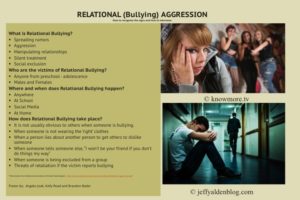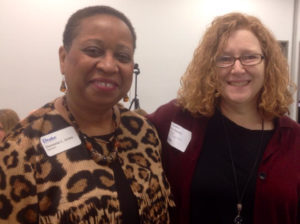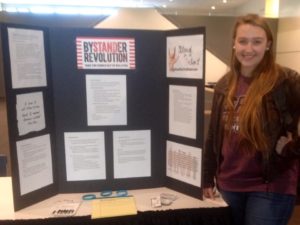Tag: social justice
Ian Estrem created this digital story in the Drake University J-term class SCS 153: Documentary Video Challenge: Digital Storytelling for Social Justice, taught by Professor Sandra Patton-Imani.
Natalie Larimer created this digital story in Documentary Video Challenge: Digital Storytelling for Social Justice, a 2017 J-term course taught by Professor Sandra Patton-Imani, Department for the Study of Culture and Society, Drake University.
 Kelly Read, Angela Leak, Brandon Bader
Kelly Read, Angela Leak, Brandon Bader
Relational Bullying is the opposite of physical bullying, yet just as damaging to self-esteem if not more so. The wounds from physical bullying may fade after time but wounds from relational bullying can last for years if not a lifetime. Some examples of relational bullying are peer pressure, gossip, social exclusion and feigning friendship to gain trust of the victim. According to a study by the University of Illinois by Rodkin et al, bullies have been known to either have high self-esteem, or worse, be former victims of bullying themselves (2015). Some of these perpetrators have been marginalized socially themselves, suffer from low self-esteem, and use bullying as a way to take their anguish out on someone else. Additionally, although some bullies come from good homes, just as many come from dysfunctional homes with abusive parents.
With the popularity of the internet, the amount of relational bullying has exploded. Victims are no longer able to escape their bullies by leaving the school and going home, instead the abuse continues at home online. Especially with the widespread use of smartphones now, at times it is inescapable. The abuse has intensified online as well. Perpetrators create Facebook pages for example, inviting peers to trade information about the victim and post pictures, all without permission. This particular method has resulted in countless suicides. Just recently, there was an article on npr.org about the announcement that for girls aged 15-19 suicide is now the #1 cause of death(2015). Although this statistic may not be entirely due to bullying, it is without a doubt it is a large factor.
There are many psychological temperaments that a bully may have. Some of these are: Anger, Depression, and Anxiety. Anger management should be part of teaching children in the no bullying area. Teaching children at a young age, on through adolescence on how to control their anger and even direct it in a more productive way. Anger and aggression are main components of bullying. Depression is common on victims of bullies and in bullies themselves. This area is important because depression leads to suicides, especially in middle-school aged children. Victims of bullies often have depression, therefore these children are the most at-risk. Anxiety is also a component of bullies and of bullied victims. Anxiety can cause students to miss school thus heightening anxiety for having to return and having to face peers and teachers and homework.
The feminist social justice approach is to treat the bullies and the victims the same. Meaning, teach each child the same for the symptoms and psychological aspects as listed above.
We should all be treated the same. The laws in this country allow all children to have a free education and therefore we all have to live together. Approaching the problem of bullying
From a psychological aspect should alleviate the bullying problems we are currently facing.
Preschoolers through adolescence have been bullies. Preschoolers do not have the verbal and cognitive skills to hide it as well as the older children, therefore it is easier to recognize.
As children age, they gain skills in which they could covertly bully other students. Being a victim of a bully also causes children to be rejected by their peers. Not only are they being victimized by the bully, but then rejected by others because they cannot defend themselves, nor will anyone assist the victim. Boys and girls are both equally bullies and victims.
Educators are more focused on physical bullying than relational bullying. Relational bullying is hard to recognize because it can be verbal, silent, on social media, through notes, whatever way the bully can get to the victim. It can be subtle, for example, “You can’t sit with us at lunch today.” or “You can’t be friends with us today.” The child would be alienated from their ‘normal’ group of friends. There is no evidence of this behavior and of course the bully will not admit it. Educators would not easily recognize this unless it is self-reported. By being aware of their students and care monitoring of these students, being able to identify bullies and victims would become more prevalent. Adults, though, typically ignore this type of bullying and disregard it as, oh, boys will be boys, or those girls always stay together.
To combat this, educators need to be aware of the subtle signs of relational bullying and not rely on the victim to speak out. Schools might even need to look into support staffs that are IT savvy who will take on the responsibility of monitoring social networking for signs of trouble. Schools could also have anonymous ways of reporting harassment for those who want to report instances of relational bullying. As bullying has evolved, methods to combat them need to evolve as well. Educators as well as administrators and staff need to think outside the box so to speak. Obviously we will never be able to eradicate peer to peer relational bullying completely, but we can at least try.
Works Cited
http://www.cdc.gov/violenceprevention/pub/youth_suicide.html
http://www.stopbullying.gov/what-is-bullying/definition/index.html
http://nobullying.com/relational-bullying/
http://www.npr.org/sections/goatsandsoda/2015/06/02/409731413/suicide-no-1-cause-of-death-for-older-teen-girls
Rodkin, P. C., Espelage, D. L., & Hanish, L. D. (2015). A relational framework for understanding bullying: Developmental antecedents and outcomes. American Psychologist, 70(4), 311-321. doi:10.1037/a0038658
Tasha Alexander, Zachary Berman, Ally Calvert, Hannah Hennessy, Reed Timmer
We researched the subject of the prohibitive culture of snitching. We found that there is a fear of snitching, not only because of the social repercussions of peers finding out, but also because of ineffective action taken by the confidant the person being bullied turned to for help. The documentary Bully tells the story of five students who struggle daily with bullying. Three of the students attempt to commit suicide, and two succeed. The adults in the film were ineffective in stopping the bullying or even exacerbated it. We also read a paper called Age, Race, Class and Sex: Women Redefining Differences, by Audre Lorde. It discusses societal norms that each generation passes down to each other and questions why we continue carrying some of these norms if they preach inequality. This applies to bullying, as society teaches children that they are superior to others because of the intelligence, race, gender, or athletic ability. Rather, society should take feminist social justice approach, where people are treated as equals without uncontrollable factors giving certain people power.
The importance of Bully, is to show and tell stories of kids who might not get a chance to share their side of the story, because of the fact that they are scared to tell on the bully. The obvious repercussions of the movie are suicide and two out of the five kids who were bullied commit suicide. This shows how bullying people, cannot only change one person’s life, but everyone who was close to the person who was bullied. In Age, Race, Class and Sex: Women Redefining Differences, demonstrates different inequalities that they go through, what they do to get through it, and how it changed their lives. It also shows how social norms can be considered bullying. Just because some one is different, doesn’t mean that they are not as important as a dominant class of people.
In relation to the prohibitive culture of snitching and what we found in our research, all the information we found can help change the way people understand and talk about bullying. Specifically, the education of all parties involved in a bullying situation needs to be implemented in order for bullying situations to be taken seriously and for them to stop. The ramifications however could be that the bullying situation gets worse as the snitch or the person trying to share information about the bullying situation could get picked on or hurt just as much as the victim. In order for this to be avoided, a number of people need to come forward in an effort to stop the bullying at its source all at the same time. There is power in numbers and if multiple people come after the situation to try and stop it, the bully then can’t in turn victimize the information sharer because there are so many people that would be involved. Sharing information and snitching can be a vital asset to a bullying situation in order to make sure the victim doesn’t go through any more harm, and another ramification could be that information or people snitching on a bullying situation could go away. In order to avoid this, it is important to make sure that the environment to share information is a friendly one with assurance that anyone who comes forward to help is doing a positive thing and does not have to worry whatsoever.
Our recommendation for social change is to get every school involved with the Stand for the Silent organization. This organization has made great strides in the past five years to raise awareness of bullying and to help prevent further bullying. The organization has been a support group for families that have lost children from bullying. In the subject of snitching, we want students to know that it is okay to stand up for someone in need. Children are sponges for learning and already support many organizations that are personal to them, cancer being a big one. Educating kids on the techniques of helping someone that is being bullied can save hundreds of lives. Stand for the Silent is a support organization kids, families, and schools can get heavily involved in. Making the cases of bullying relatable to each student will help them take the stand that is necessary.
Senior Sociology major Annelise Tarnowski, a student in Introduction to Women’s and Gender Studies, shares her group’s research on bystander intervention.
WHO reported on our conference: http://whotv.com/2015/03/26/educators-bullying-must-be-addressed-at-elementary-grade-level/

Senior Sociology major Ravi Patel, showing videos he assembled for the event as part of an independent study with Dr. Patton-Imani. The short clips are an edited version of the project, “Bullying Society” that students, including Ravi, created during 2015 J-term course, SCSA 158: Documentary Video Challenge.

Provost, Dr. Dee Jones and Dr. Sandi Patton-Imani
Drake University Provost, Dr. Deneese Jones welcomed educators from throughout the state to the 2nd Annual Conference on Bullying: Investigation and Resolution. On March 26, 2015 elementary education administrators, investigators, and school counsellors from all over Iowa were introduced to Dr. Sandra Patton-Imani’s prevention program, “Critical Empathy: A Social Justice Approach to Prevention,” and Amanda Easton’s approach to investigation, the Easton Bullying Investigation System (EBIS). Students in Dr. Patton-Imani’s Introduction to Women’s and Gender Studies course conducted research on bullying prevention and presented it at poster sessions throughout the day. T The event was cosponsored by the Women’s and Gender Studies Program, the Provost’s Office, the Department for the Study of Culture and Society, the Office of Service Learning, and Stand for the Silent, a national bystander prevention program.



